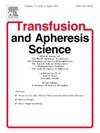加纳阿克拉南部地区血液中心献血者铁水平和血液学指标的评估
IF 1.2
4区 医学
Q4 HEMATOLOGY
引用次数: 0
摘要
献血对于维持生命至关重要,但筛查通常只关注血红蛋白,而忽略了铁的储存。虽然血红蛋白恢复得很快,但铁需要更长的时间来补充,这使得经常献血的人处于危险之中。即使没有贫血,低铁也会导致疲劳、耐力下降和认知问题,潜在地导致缺铁性贫血。许多项目都忽略了铁元素的状况,导致常规捐助者长期缺乏铁元素。目的了解不同类型献血者的铁含量及血液学指标。方法本横断面研究从加纳阿克拉的南部地区血液中心招募了350名献血者,其中146名是首次献血者,146名是重复献血者,58名是血红蛋白延迟献血者。对于每个参与者,获得约3 mL的血液样本来估计FBC的血液学参数和血清铁蛋白浓度的铁状态。结果该研究涉及350名献血者,发现Hb中位数为12.4 g/dL,铁蛋白水平范围为11.8至500 ng/mL。首次献血者Hb分布呈正偏态,而重复献血者Hb分布差异较大,存在异常值。两组间Hb、MCV、MCHC、RDW和血清铁蛋白差异有统计学意义(p <; 0.001),MCH差异无统计学意义(p = 0.062)。16.7% %的参与者缺铁,8.3% %的参与者红细胞缺铁性,75% %的参与者铁蛋白水平正常。结论本研究结果强调了不同供体类型在铁储量和血液学参数上的差异,强调了供体频率对铁状态的影响。这项研究提供了新的证据,从加纳献血频率如何影响铁储备和血液学指标。本文章由计算机程序翻译,如有差异,请以英文原文为准。
Evaluation of iron levels and hematological indices among blood donors at the Southern Zonal Blood Center, Accra, Ghana
Background
Blood donation is essential for maintaining life-saving supplies, but screening often focuses only on hemoglobin, neglecting iron stores. While hemoglobin recovers quickly, iron takes longer to replenish, putting frequent donors at risk. Even without anemia, low iron can cause fatigue, reduced endurance, and cognitive issues, potentially leading to iron-deficiency anemia. Many programs overlook iron status, leaving regular donors vulnerable to chronic depletion.
Objective
The objective of the study was to assess the iron status and haematological indices of categories of blood donors.
Methods
This cross-sectional study recruited 350 blood donors of which 146 were first-time donors, 146 repeat donors, and 58 hemoglobin-deferred donors from the Southern Zonal Blood Center, Accra, Ghana. For each participant, about 3 mL of blood sample was obtained to estimate FBC for haematological parameters and serum ferritin concentration for iron status.
Results
The study involved 350 blood donors and found a median Hb of 12.4 g/dL and ferritin levels ranging from 11.8 to 500 ng/mL. First-time donors showed a positively skewed Hb distribution, while repeat donors had greater variation with outliers. Significant differences (p < 0.001) in Hb, MCV, MCHC, RDW, and serum ferritin were observed across the groups, though MCH showed no significant difference (p = 0.062). Iron depletion was present in 16.7 % of participants, whilst 8.3 % had iron-deficient erythropoiesis, and 75 % had normal ferritin levels.
Conclusion
The findings of the study highlight the differences in iron reserves and hematological parameters among donor categories, emphasizing the impact of donation frequency on iron status. This study provides new evidence from Ghana on how blood donation frequency affects iron reserves and haematological indices.
求助全文
通过发布文献求助,成功后即可免费获取论文全文。
去求助
来源期刊
CiteScore
3.60
自引率
5.30%
发文量
181
审稿时长
42 days
期刊介绍:
Transfusion and Apheresis Science brings comprehensive and up-to-date information to physicians and health care professionals involved in the rapidly changing fields of transfusion medicine, hemostasis and apheresis. The journal presents original articles relating to scientific and clinical studies in the areas of immunohematology, transfusion practice, bleeding and thrombotic disorders and both therapeutic and donor apheresis including hematopoietic stem cells. Topics covered include the collection and processing of blood, compatibility testing and guidelines for the use of blood products, as well as screening for and transmission of blood-borne diseases. All areas of apheresis - therapeutic and collection - are also addressed. We would like to specifically encourage allied health professionals in this area to submit manuscripts that relate to improved patient and donor care, technical aspects and educational issues.
Transfusion and Apheresis Science features a "Theme" section which includes, in each issue, a group of papers designed to review a specific topic of current importance in transfusion and hemostasis for the discussion of topical issues specific to apheresis and focuses on the operators'' viewpoint. Another section is "What''s Happening" which provides informal reporting of activities in the field. In addition, brief case reports and Letters to the Editor, as well as reviews of meetings and events of general interest, and a listing of recent patents make the journal a complete source of information for practitioners of transfusion, hemostasis and apheresis science. Immediate dissemination of important information is ensured by the commitment of Transfusion and Apheresis Science to rapid publication of both symposia and submitted papers.

 求助内容:
求助内容: 应助结果提醒方式:
应助结果提醒方式:


